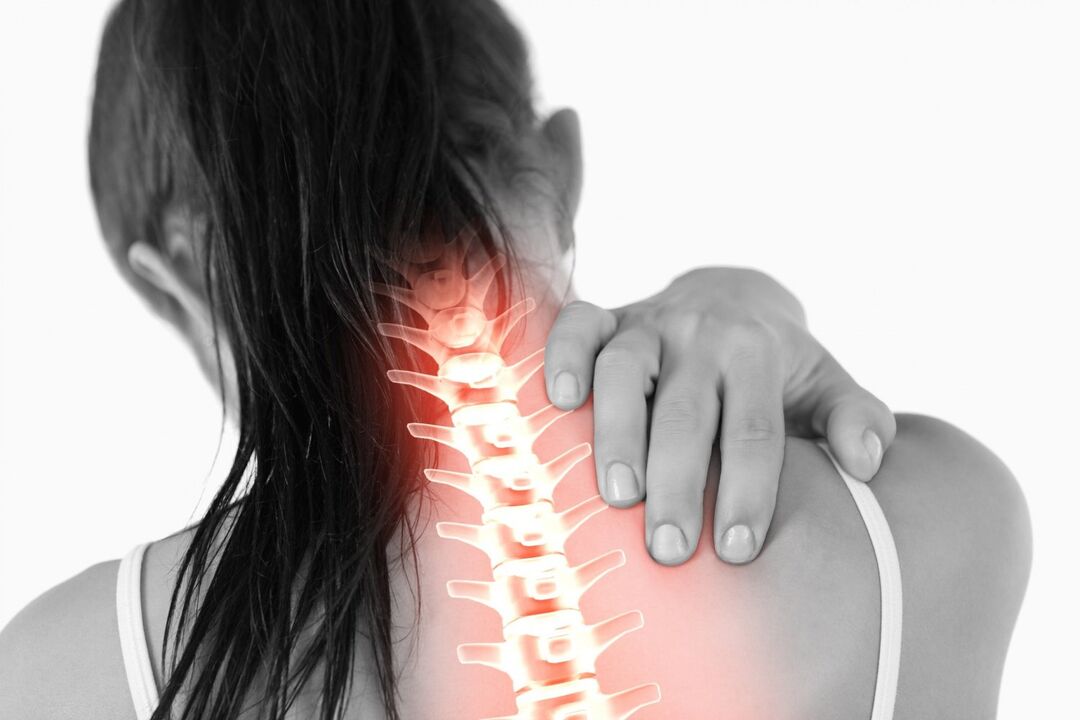
The most common cause of pain in the upper and middle parts of the back is tarsal osteonecrosis. And while this slowly progressive disease is not fatal, it significantly worsens a person's quality of life, and in some cases can cause disability. And only as much as possible elimination of the factors that lead to unequal pressure on the moving segments of the spine can slow the irreversible biological aging process and thus alleviate the condition. .
Causes of degenerative spine injury
Cervical osteosarcoma is a multifactorial pathology of the intervertebral disc connecting the 7 cervical vertebrae and 12 thoracic vertebrae. The most common causes of degenerative changes are:
- gravity (displacement of center of gravity and redistribution of axial loads)
- prolonged work in a forced position
- vibrate
- reduced motivation
- autoimmune disease
- Spinal overload associated with pathologies of the musculoskeletal system (malformations, flat feet)
- infectious and inflammatory processes in adjacent structures
- metabolic disorder
- Genetic anomalies in the development of connective tissue
- injury
- Excessive static or dynamic load
- hormone imbalance
Causes of exacerbations of osteonecrosis in men and women can be stress, prolonged nervous tension, malnutrition, hypothermia.
Symptoms of osteonecrosis of the cervical and thoracic spine
The degenerative process in the affected discs is accompanied by local pain syndromes and glans. Due to a violation of the blood supply to the brain, the patient complains of headache, dizziness, "flies" in front of the eyes, pain in the shoulder or the entire upper extremities, in the intercostal and intercostal regions. There is discomfort, tingling in the neck, chest, abdomen, periodic sharp pain in the ears or temples, pain when coughing and sneezing.
After a long time in a forced position, a feeling of being squeezed will appear. Usually, cervical osteonecrosis occurs with typical cardiac symptoms, which greatly complicates the diagnosis. Among additional signs, you should highlight numbness in certain areas of the skin, disturbances of the gastrointestinal tract, increasing pain with deep breathing, shortness of breath when lying on your back.
Stages of osteonecrosis
The pathological process has 4 stages of development:
I - swelling and movement of the medullary substance inside the disc, irritation of the peripheral nerve endings. Low back pain in the neck and chest that occurs against the background of physical activity
II - annulus fissure, violation of the fixation between the vertebral bodies, instability of the vertebral segments. Accompanied by continuous muscle tension, functional blockade, limited mobility
III - rupture of the disc membrane and protrusion of the nucleus pulposus (herniation). The nerve root compression syndromes are manifested by reflex prolapse, weakness, atrophy, disturbance of sensitivity in the inner region II - capsular fissure, impaired fixation between vertebral bodies, instability of vertebral segments. Accompanied by continuous muscle tension, functional blockade, limited mobility
IV - degenerative lesions of all components of disc degeneration. Due to the mineralization and compaction of the disc, the degenerative process of the facet joints develops and mobility in the affected area is significantly limited.
Diagnostic method
Diagnosis of vertebral pathology is made complex, which includes:
- Important history and pathology collection
- physical examination in a static position
- diagnostic tests (study of disorders of active and passive movement)
- determine neurological status
- Biplane radiographs of the spine
- CT
- MRI
In a professional clinic, when diagnosing various pathologies, magnetic resonance imaging is performed in conjunction with manual testing. The combined use of these methods provides complete information on the location of the detected dysregulated areas, the cell structure and metabolic activity, and the state of all soft tissue components.
Which doctor to contact?
A neurologist manages patients with osteogenic disorders. In addition, you may need the help of an orthopedic surgeon or a spine surgeon.
How to treat ankle bone necrosis?
Treatment of osteonecrosis of the cervical and thoracic spine includes:
- pain reliever, swelling and inflammation
- manual therapy
- massage and self-massage;
- physiotherapeutic procedures (UVI, electrophoresis, laser-, magnetic therapy, DDT)
- Acupressure
- physical therapy exercises
- corseting, pins
- relax after isostatic
If osteonecrosis is complicated by a herniated disc, the patient should have surgery.
Effect
An indifferent attitude to a person's health and disregard of medical recommendations can lead to an active progression of the pathological process and the development of various reflex and compression syndromes:
- cervical pain and chronic chest pain (headache radiating from the occipital region, pain in the chest area)
- Avoid tilting the head in the direction opposite to the injury.
- vegetative disorders of the upper extremities
- sensory problems in the hands and fingers
- dysfunction of internal organs
- immobilize part of the spine
- disabilities
Prevention of ankle bone necrosis
To minimize the impact of negative factors, it is recommended to regularly perform exercises aimed at strengthening the muscular frame. It is very important during prolonged monotonous work to monitor posture, change body position more often, avoid large amplitude movements and protect yourself from hypothermia and drafts.
























